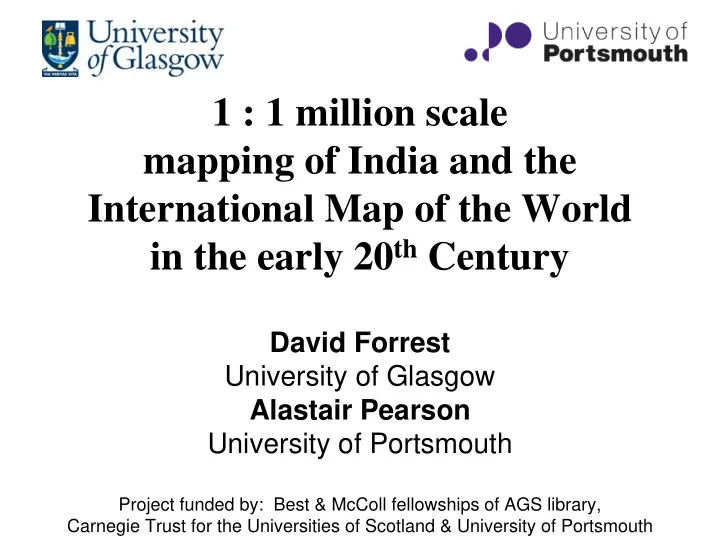

1 : 1 million scale mapping of India and the International Map of the World in the early 20 th Century David Forrest University of Glasgow Alastair Pearson University of Portsmouth Project funded by: Best & McColl fellowships of AGS library, Carnegie Trust for the Universities of Scotland & University of Portsmouth
Outline • Progress with topographic mapping of India • India and Adjacent Countries Series • International Map of the World • Indian mapping and the IMW • Conclusions
Introduction • The International Map of the World (IMW) – Proposed late 19 th Century at IGC Congresses – Special meeting on IMW London 1909 • Basic specifications agreed • Produced by many countries until late twentieth century • Part of an ongoing study into the history, development & use of the IMW
Surveying & Mapping of India • Famous for measurement of the Great Arc – Triangulation 1800-1880 (Lambton & Everest) – ‘Discovery’ of Mt Everest 1856 • At the beginning of the C20 th – Making good progress towards detailed survey of India for topographic mapping at various scales – Major focus was ‘Indian Atlas’ at 4 miles to 1” – Many larger scale maps
Progress 1906
Early mapping 16mile map of Punjab, 1890 1:1M 1903 – including hachures
Review of SoI • Major government review of SoI • Indian Survey Committee appointed 1904 by Governor-General of India • Reported 1905 • Report had major influence on activities and publishing for many years
India And Adjacent Countries Series • A long held desire was a uniform map at 16 miles to the inch • India Survey Committee recommended new series at 1:1M scale (15.78” to the Mile) • To cover not just India, but adjacent countries largely under British control, influence, or interest
I&AC index & progress, 1919 • Each sheet 4 deg * 4 deg • Single secant conical projection – Std parallels at 8 & 40 degrees N • Sheet arrangement forms organisational basis of larger scale mapping – Each I&AC sheet divided into 16 1:250k 1*1 degree sheets of the India Atlas – Larger scale mapping further subdivisions – Sheet numbering starts with I&AC number
I&AC • Early maps redrawn from older material – Provisional edition – Produced by heliozincography from drawn orignals – No contouring Sheet 47, 1910
I&AC development • Maps redrawn as modern larger scale mapping prepared • Full contouring included based on 1” to 1 mile surveys • Regular edition produced by engraving
I&AC relief versions
International Map of the World • India not directly involved in discussions about creating IMW – Not invited to 1909 meeting – Indirectly represented by War Office, London • SoI were aware of IMW proposals – 1903 paper on selection of projection considers IMW development, but make own decision as can’t wait • 1911: Directive from War Office that SoI mapping should comply with IMW specifications – Major inconvenience as 29 sheets of I&AC already published
I&AC & IMW • Although same scale, not a simple task to move to IMW • Different projections • Different sheetlines – I&AC – 4*4 deg IMW 4*6 deg • Units – Imperial units metric units • Content & symbolisation – Eg contour lines – brown vs black • Relief representation
IMW sheetlines 1919
IMW Conference of 1913 • Government of India invited to send representation to 1913 conference – Deputy Superintendent Major Tandy attended • Sheet 53 of I&AC exhibited – Only map not based on 1909 IMW specs – The design attracted significant attention – Claimed that relief representation influenced revised IMW specification
Relief representation • Different scales of heights •I&AC in feet •IMW in metres •Different colour sets •India had done much experimentation on production of hyposmetric layers
1914 I&AC vs IMW 1915
Conclusions • Survey of India independently developed a ‘modern’ style of 1:1M map – Designed to fit needs of India, not global map – Had some influence on IMW design • When directed, responded positively to challenge of producing IMW – This lead to maintaining and publishing two parallel series at 1:1M until mid C20 Funding for the project by: Best & McColl fellowships of AGS library, Carnegie Trust for the Universities of Scotland & University of Portsmouth
Recommend
More recommend